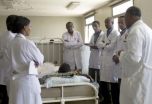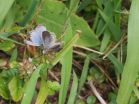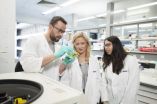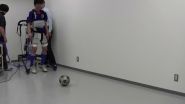(Press-News.org) Researchers at UC Santa Cruz have developed a new approach for studying single molecules and nanoparticles by combining electrical and optical measurements on an integrated chip-based platform. In a paper published July 9 in Nano Letters, the researchers reported using the device to distinguish viruses from similarly-sized nanoparticles with 100 percent fidelity.
Combining electrical and optical measurements on a single chip provides more information than either technique alone, said corresponding author Holger Schmidt, the Kapany Professor of Optoelectronics in the Baskin School of Engineering and director of the W. M. Keck Center for Nanoscale Optofluidics at UC Santa Cruz. Graduate student Shuo Liu is first author of the paper.
The new chip builds on previous work by Schmidt's lab and his collaborators at Brigham Young University to develop optofluidic chip technology for optical analysis of single molecules as they pass through a tiny fluid-filled channel on the chip. The new device incorporates a nanopore that serves two functions: it acts as a "smart gate" to control the delivery of individual molecules or nanoparticles into the channel for optical analysis; and it allows electrical measurements as a particle passes through the nanopore.
"The nanopore delivers a single molecule into the fluidic channel, where it is then available for optical measurements. This is a useful research tool for doing single-molecule studies," Schmidt said.
Biological nanopores, a technology developed by coauthor David Deamer and others at UC Santa Cruz, can be used to analyze a DNA strand as it passes through a tiny pore embedded in a membrane. Researchers apply voltage across the membrane, which pulls the negatively charged DNA through the pore. Current fluctuations as the DNA moves through the pore provide electrical signals that can be decoded to determine the genetic sequence of the strand.
With the new device, researchers are able to gather electrical measurements on a nanoparticle as it moves through a pore in a solid membrane, and then measure the optical signals when the particle encounters a beam of light in the channel. By correlating the strength of the current decrease as a particle moves through the pore, the intensity of the optical signal, and the time of each measurement, the researchers are able to discriminate among particles with different sizes and optical properties and to determine the flow speed of particles through the channel.
The chip can also be used to differentiate particles of similar size but different composition. In one experiment, the researchers combined influenza viruses with nanobeads of a similar diameter and placed the mixture above the nanopore. The virus was labeled with a red fluorescent tag and the beads were labeled with a blue tag. The researchers correlated the electrical signal with the fluorescent wavelength and the time of each measurement. They found that the blue nanobeads traveled faster through the channel than red influenza virus, perhaps because of a difference in surface charge or mass. Besides identifying pathogens in a mixture, the researchers can also count the number of virus particles.
"This could be used as an analytical device to do reliable counts of virus particles in a sample," Schmidt said.
Currently, Schmidt's group is working on methods to add optical trapping to the device. This would allow a molecule in the channel to be held in one place, investigated, and released, with the potential to analyze hundreds of molecules in an hour. "Having this all on one chip would make single-molecule measurements much easier and more convenient," Schmidt said.
INFORMATION:
In addition to Liu and Schmidt, the coauthors include UCSC graduate student Joshua Parks, and Yue Zhao and Aaron Hawkins at Brigham Young University. This work was supported by the Keck Center for Nanoscale Optofluidics and grants from the National Science Foundation and National Institutes of Health.
Novel chip-based platform could simplify measurements of single molecules
A nanopore-gated optofluidic chip combines electrical and optical measurements of single molecules onto a single platform
2014-08-14
ELSE PRESS RELEASES FROM THIS DATE:
Stem cells in the skeletal muscle promote the regeneration of severe nerve peripheral injury
2014-08-14
A research group at the muscle physiology and cell biology unit, the Tokai University School of Medicine, Japan, led by Dr. Tetsuro Tamaki, have developed the stem cell isolation method from the skeletal muscle, termed skeletal muscle-derived multipotent stem cells (Sk-MSCs), which can differentiate into Schwann and perineurial/endoneurial cells, and vascular relating pericytes, endothelial and smooth muscle cells in the damaged peripheral nerve niche. Application of the Sk-MSCs in the bridging conduit of the long nerve gap injury resulted favorable axonal regeneration ...
Up-regulation of neuronal alpha-1 adrenoceptors after peripheral nerve injury
2014-08-14
In a Perspectives paper published in Neural Regeneration Research (Vol. 9, No. 14), Professor Peter Drummond speculates about neuronal changes that might contribute to chronic pain after peripheral nerve injury. Professor Drummond and co-workers at Murdoch University, Perth Western Australia, discovered recently that the expression of α1-adrenoceptors increases on pain-signalling nerve fibers that survive peripheral injury. As these receptors boost neural excitability, an increase in their expression could intensify pain. After tissue injury, resident cells and other ...
New frontiers of fecal microbiota transplantation
2014-08-14
Bethesda, MD (Aug. 14, 2014) – Fecal microbiota transplantation (FMT) is one of the most innovative new treatments of the 21st century. Experts believe that this procedure, which transplants microbes from one human gut to another through fecal matter, could offer the cure to a vast range of diseases and shed new light on the role of the microbiome in gastrointestinal diseases. New research presented this weekend at the American Gastroenterological Association's 2014 James W. Freston Conference in Chicago, IL, highlights significant advances in this field, and confirms the ...
Scientists detail urgent research agenda to address chronic disease toll
2014-08-14
Health care systems that keep HIV patients from dying early in low- and middle-income nations need urgently to be repurposed to treat the chronic diseases that many of these patients now have, experts say.
According to recommendations resulting from a multidisciplinary conference sponsored by the National Institutes of Health, scientists and physicians in low- and middle-income countries should build on existing HIV research to study and treat chronic conditions. Patients once condemned to death by AIDS now suffer from noncommunicable diseases such as tuberculosis, cancer, ...
Study of Chilean quake shows potential for future earthquake
2014-08-14
Near real-time analysis of the April 1 earthquake in Iquique, Chile, showed that the 8.2 event occurred in a gap on the fault unruptured since 1877 and that the April event was not what the scientists had expected, according to an international team of geologists.
"We assumed that the area of the 1877 earthquake would eventually rupture, but all indications are that this 8.2 event was not the 8.8 event we were looking for," said Kevin P. Furlong, professor of geophysics, Penn State. "We looked at it to see if this was the big one."
But according to the researchers, ...
People fake to look authentic on social media
2014-08-14
Presenting an authentic image on social network sites (SNSs) includes an element of fakery according to a new study by researchers at Aalto University. During the study, researchers discovered that being authentic is very important for social media users. At the same time, users also admitted faking parts of their online image in order to conform to social norms and expectations.
By focusing on two SNSs, Facebook and Last.fm, the researchers came to the conclusion that being real is much more acceptable according to social norms.
Although both of these SNSs differ ...
Fukushima's legacy
2014-08-14
Following the 1986 Chernobyl nuclear power plant meltdown, biological samples were obtained only after extensive delays, limiting the information that could be gained about the impacts of that historic disaster. Determined not to repeat the shortcomings of the Chernobyl studies, scientists began gathering biological information only a few months after the disastrous meltdown of the Fukushima Daiichi power plant in Japan in 2011. Results of these studies are now beginning to reveal serious biological effects of the Fukushima radiation on non-human organisms ranging from ...
Immune cell discovery could help to halt cancer spread
2014-08-14
Melbourne researchers have revealed the critical importance of highly specialised immune cells, called natural killer cells, in killing melanoma cells that have spread to the lungs.
These natural killer cells could be harnessed to hunt down and kill cancers that have spread in the body.
The team, from the Walter and Eliza Hall Institute, also found natural killer cells were critical to the body's rejection of donor bone marrow transplants and in the runaway immune response during toxic shock syndrome.
The discoveries came after the team showed that a protein called ...
Newborns' genetic code sends infection distress signal
2014-08-14
Babies suffering from life-threatening bacterial infections such as sepsis could benefit from improved treatment, thanks to a ground-breaking study.
For the first time, researchers have been able to detect and decode a signal generated from a baby's DNA that can tell doctors whether or not a bacterial infection is present in the bloodstream.
The findings could help develop a test for bacterial infection in newborns, using a single drop of blood.
Immediate detection of such infections, which are a major cause of death among young children, is currently impossible ...
Bypass commands from the brain to legs through a computer
2014-08-14
VIDEO:
The right arm muscles and the locomotion center of the man are artificially connected through a computer. His legs are in a relaxed state. When he moves his right hand,...
Click here for more information.
Gait disturbance in individuals with spinal cord injury is attributed to the interruption of neural pathways from brain to the spinal locomotor center, whereas neural circuits locate below and above the lesion maintain most of their functions. An artificial connection ...
LAST 30 PRESS RELEASES:
COVID-19 leaves a lasting mark on the human brain
Scientists use ultrasound to soften and treat cancer tumors without damaging healthy tissue
Community swimming program for Black youth boosts skills, sense of belonging, study finds
Specific depressive symptoms in midlife linked to increased dementia risk
An ‘illuminating’ design sheds light on cholesterol
Who is more likely to get long COVID?
Study showcases resilience and rapid growth of “living rocks”
Naval Research Lab diver earns Office of Naval Research 2025 Sailor of the Year
New Mayo-led study establishes practical definition for rapidly progressive dementia
Fossil fuel industry’s “climate false solutions” reinforce its power and aggravate environmental injustice
Researchers reveal bias in a widely used measure of algorithm performance
Alcohol causes cancer. A study from IOCB Prague confirms damage to DNA and shows how cells defend against it
Hidden viruses in wastewater treatment may shape public health risks, study finds
Unlock the power of nature: how biomass can transform climate mitigation
Biochar reshapes hidden soil microbes that capture carbon dioxide in farmland
Reducing saturated fat intake shows mortality benefit, but only in high-risk individuals
Manta rays create mobile ecosystems, study finds
Study: Mixed results in using lipoic acid to treat progressive multiple sclerosis
Norbert Holtkamp appointed director of Fermi National Accelerator Laboratory
New agentic AI platform accelerates advanced optics design
Biologists discover neurons use physical signals — not electricity — to stabilize communication
Researchers discover that a hormone can access the brain by hitchhiking
University of Oklahoma researcher awarded funding to pursue AI-powered material design
Exploring how the visual system recovers following injury
Support for parents with infants at pediatric check-ups leads to better reading and math skills in elementary school
Kids’ behavioral health is a growing share of family health costs
Day & night: Cancer disrupts the brain’s natural rhythm
COVID-19 vaccination significantly reduces risk to pregnant women and baby
The role of vaccination in maternal and perinatal outcomes associated with COVID-19 in pregnancy
Mayo Clinic smartwatch system helps parents shorten and defuse children's severe tantrums early
[Press-News.org] Novel chip-based platform could simplify measurements of single moleculesA nanopore-gated optofluidic chip combines electrical and optical measurements of single molecules onto a single platform



